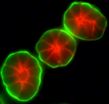(Press-News.org) An international team of researchers including professor Emmett Duffy of the Virginia Institute of Marine Science has published a comprehensive new analysis showing that loss of plant biodiversity disrupts the fundamental services that ecosystems provide to humanity.
Plant communities—threatened by development, invasive species, climate change, and other factors—provide humans with food, help purify water supplies, generate oxygen, and supply raw materials for building, clothing, paper, and other products.
The 9-member research team, led by professor Brad Cardinale of the University of Michigan, analyzed the results of 574 field and laboratory studies—conducted across 5 continents during the last 2 decades—that measured the changes in productivity resulting from loss of plants species. This type of "meta-analysis" allows researchers to move beyond their own individual or collaborative studies to get a much more reliable global picture. Their study appears in the March special biodiversity issue of the American Journal of Botany.
"The idea that declining diversity compromises the functioning of ecosystems was controversial for many years," says Duffy, a marine ecologist who has studied the effects of biodiversity loss in seagrass beds. "This paper should be the final nail in the coffin of that controversy. It's the most rigorous and comprehensive analysis yet, and it clearly shows that extinction of plant species compromises the productivity that supports Earth's ecosystems."
The team's analysis shows that plant communities with many different species are nearly 1.5 times more productive than those with only one species (such as a cornfield or carefully tended lawn), and ongoing research finds even stronger benefits of diversity when the various other important natural services of ecosystems are considered. Diverse communities are also more efficient at capturing nutrients, light, and other limiting resources.
The analysis also suggests, based on laboratory studies of algae, that diverse plant communities generate oxygen—and take-up carbon dioxide—more than twice as fast as plant monocultures.
The team's findings are consistent for plant communities both on land and in fresh- and saltwater, suggesting that plant biodiversity is of general and fundamental importance to the functioning of the Earth's entire biosphere.
Duffy, Loretta and Lewis Glucksman Professor of Marine Science at VIMS, says the team's findings are important locally because estuaries like Chesapeake Bay are naturally low in plant diversity, making them especially vulnerable to ecological surprises resulting from loss of species.
"Salt marshes and seagrass beds depend largely on one or a few species of plants that create the habitat structure," says Duffy. "When such species are lost, low diversity means there is often no one else to take their place and the effects can ripple out through the community of animals, potentially up to fishery species."
In addition to analyzing the general effects of biodiversity loss, the team also sought to determine the specific fraction of plant species needed to maintain the effective functioning of a particular ecosystem—important information for resource managers with limited human and financial resources to manage forests, marine reserves, and other protected areas on land and sea. The results of this effort were mixed, and the team's ongoing research is tackling this question.
Data from the study did suggest, however, that biodiversity loss may follow a "tipping-point" model wherein some fraction of species can be lost with minimal change to ecological processes, followed by a sharp drop in ecosystem function as species loss continues.
Biodiversity loss in the real world
Recognizing that their findings mostly rest on analysis of short-term experiments (generally a few days, weeks, or months) in relatively small settings, the researchers also attempted to determine how diversity effects "scale-up" to longer time scales, bigger areas, or both. The authors note that these are the real-world scales "at which species extinctions actually matter and at which conservation and management efforts take place."
The team's findings suggest that scale does indeed matter, and that small laboratory and field experiments typically underestimate the effects of biodiversity loss. In the researchers' own words, "Data are generally consistent with the idea that the strength of diversity effects are stronger in experiments that run longer, and in experiments performed at larger spatial scales."
Duffy is now further testing this scaling issue with a 3-year grant from the U.S. National Science Foundation. He is using the grant to establish a global experimental network for studying how nutrient pollution and changes in biodiversity impact seagrass beds.
The future of biodiversity studies
The American Journal of Botany study also identifies the additional information needed to better understand biodiversity loss and its effects. Important frontiers include additional studies of how small-scale diversity experiments scale-up to real ecosystems; how biodiversity loss compares to and interacts with other environmental stressors such as climate change, invasive species, low-oxygen dead zones, ocean acidification, and water pollution; and how species-level diversity compares in importance with diversity at other levels such as genetic and functional (e.g., herbivore, grazer, or carnivore)
Cardinale says information from these types of studies will put scientists "in a position to calculate the number of species needed to support the variety of processes required to sustain life in real ecosystems." He adds, "And we don't mean 'need' in an ethical or an aesthetic way. We mean an actual concrete number of species required to sustain basic life-support processes."
Study co-author Jarrett Byrnes, of the National Center for Ecological Analyses and Synthesis, says "Species extinction is happening now, and it's happening quickly. And unfortunately, our resources are limited. This means we're going to have to prioritize our conservation efforts, and to do that, scientists have to start providing concrete answers about the numbers and types of species that are needed to sustain human life. If we don't produce these estimates quickly, then we risk crossing a threshold that we can't come back from."
INFORMATION:
Loss of plant diversity threatens Earth's life-support systems
2011-03-08
ELSE PRESS RELEASES FROM THIS DATE:
University of Maryland School of Medicine publishes scientific paper on 2001 anthrax attacks
2011-03-08
Researchers at the Institute for Genome Sciences at the University of Maryland School of Medicine and collaborators at the FBI, the U.S. Army Medical Research Institute of Infectious Diseases and Northern Arizona University have published the first scientific paper based on their investigation into the anthrax attacks of 2001. The case was groundbreaking in its use of genomics and microbiology in a criminal investigation. More than 20 people contracted anthrax from Bacillus anthracis spores mailed through the U.S. Postal Service in 2001, and five people died as a result ...
Berkeley Lab researchers illuminate laminin's role in cancer formation
2011-03-08
Laminin, long thought to be only a structural support protein in the microenvironment of breast and other epithelial tissues, is "famous" for its cross-like shape.
However, laminin is far more than just a support player with a "pretty face." Two studies led by one of the world's foremost breast cancer scientists have shown how laminin plays a central role in the development of breast cancer,
the second most common cancer and second leading cause of cancer death among women in the United States. In one study it was shown how laminin influences the genetic information ...
What doctors (and patients) can learn from air traffic controllers: What's that you say
2011-03-08
INDIANAPOLIS – A review of 35 years of scientific medical studies confirms that the social and emotional context of the doctor–patient relationship have yet to be incorporated into the equation when it comes to health care.
In spite of its strong endorsement over a decade ago by the influential Institute of Medicine report, "Crossing the Quality Chasm: A New Health System for the 21st Century," which highlighted the benefits of care that is respectful of and responsive to patients' needs, values and concerns, patient-centered medicine has not become part of the mainstream. ...
Pathology study tracks uterine changes with mifepristone
2011-03-08
Research continues to show that the controversial abortion drug mifepristone might have another use, as a therapeutic option besides hysterectomy for women who suffer from severe symptoms associated with uterine fibroids.
The University of Rochester Medical Center in 2004 began investigating mifepristone, in a class of drugs known as progesterone receptor modulators (PRMs), to treat fibroids, which affect roughly half of all women younger than 50. Results showed the drug shrank the fibroids and greatly improved the quality of life for the women involved in the clinical ...
Scripps Research and MIT scientists discover class of potent anti-cancer compounds
2011-03-08
LA JOLLA, CA, AND JUPITER, FL – March 7, 2011 – Embargoed by the journal PNAS until March 7, 2011, 3 PM, Eastern time –Working as part of a public program to screen compounds to find potential medicines and other biologically useful molecules, scientists from The Scripps Research Institute and Massachusetts Institute of Technology (MIT) have discovered an extremely potent class of potential anti-cancer and anti-neurodegenerative disorder compounds. The scientists hope their findings will one day lead to new therapies for cancer and Alzheimer's disease patients.
The research—scheduled ...
Transplanting umbilical cord and menstrual blood-derived stem cells offer hope for disorders
2011-03-08
Tampa, Fla. (Mar. 07, 2011) – Transplanting stem cells derived from umbilical cord blood cells and menstrual blood cells may offer future therapeutic benefit for those suffering from stroke, Alzheimer's disease, and amyotrophic lateral sclerosis (ALS), says a team of neuroscience researchers from the University of South Florida's Department of Neurosurgery and Brain Repair and collaborators from three private-sector research groups, Saneron CCEL Therapeutics, Inc., Tampa, FL, Cryo-Cell International, Inc., Oldsmar, FL, and Cryopraxis, Cell Praxis, BioRio, Rio de Janeiro, ...
Research sheds light on fat digestibility in pigs
2011-03-08
Producers and feed companies add fat to swine diets to increase energy, but recent research from the University of Illinois suggests that measurements currently used for fat digestibility need to be updated.
"It's critical that we gain a better understanding of the energy value of fat," said Hans H. Stein, U of I professor in the Department of Animal Sciences. "If we don't know the true energy value of fat, we can't determine if it's economical to add to the diet."
In a recent experiment, Stein and his team of researchers studied how different types of diets affect ...
New weight loss discovery by Harvard scientists moves us closer to 'the Pill' for obesity
2011-03-08
An important discovery in mice may make a big difference in people's waistlines thanks to a team of Harvard scientists who found that reducing the function of a transmembrane protein, called Klotho, in obese mice with high blood sugar levels produced lean mice with reduced blood sugar levels. This protein also exists in humans, suggesting that selectively targeting Klotho could lead to a new class of drugs to reduce obesity and possibly Type 2 diabetes for people. This finding was recently published online in The FASEB Journal (http://www.fasebj.org).
"Our study is a ...
Ultra fast photodetectors out of carbon nanotubes
2011-03-08
This release is available in German.
Carbon nanotubes have a multitude of unusual properties which make them promising candidates for optoelectronic components. However, so far it has proven extremely difficult to analyze or influence their optic and electronic properties. A team of researchers headed by Professor Alexander Holleitner, a physicist at the Technische Universitaet Muenchen and member of the Cluster of Excellence Nanosystems Munich (NIM), has now succeeded in developing a measurement method allowing a time-based resolution of the so-called photocurrent ...
Multiple sclerosis blocked in mouse model
2011-03-08
Scientists have blocked harmful immune cells from entering the brain in mice with a condition similar to multiple sclerosis (MS).
According to researchers from Washington University School of Medicine in St. Louis, this is important because MS is believed to be caused by misdirected immune cells that enter the brain and damage myelin, an insulating material on the branches of neurons that conduct nerve impulses.
New insights into how the brain regulates immune cell entry made the accomplishment possible. Washington University scientists had borrowed an anti-cancer drug ...



